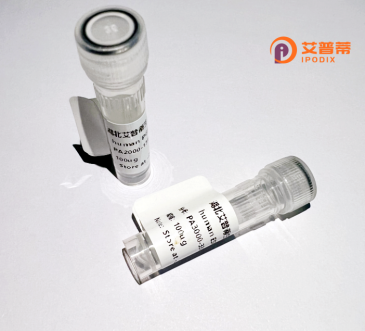
| 纯度 | >90%SDS-PAGE. |
| 种属 | Human |
| 靶点 | ITR |
| Uniprot No | Q86V85 |
| 内毒素 | < 0.01EU/μg |
| 表达宿主 | E.coli |
| 表达区间 | 1-440aa |
| 活性数据 | MGGLRLLAVALTCCWWPQGSQGKTLRGSFSSTAAQDAQGQRIGHFEFHGDHALLCVRINNIAVAVGKEAKLYLFQAQEWLKLQQSSHGYSCSEKLSKAQLTMTMNQTEHNLTVSQIPSPQTWHVFYADKYTCQDDKENSQVEDIPFEMVLLNPDAEGNPFDHFSAGESGLHEFFFLLVLVYFVIACIYAQSLWQAIKKGGPMHMILKVLTTALLLQAGSALANYIHFSSYSKDGIGVPFMGSLAEFFDIASQIQMLYLLLSLCMGWTIVRMKKSQSRPLQWDSTPASTGIAVFIVMTQSVLLLWEQFEDISHHSYHSHHNLAGILLIVLRICLALSLGCGLYQIITVERSTLKREFYITFAKGCILWFLCHPVLACISVIFSDYQRDKVITIGVILCQSVSMVILYRLFLSHSLYWEVSSLSSVTLPLTISSGHKSRPHF |
| 分子量 | 49.3 kDa |
| 蛋白标签 | GST-tag at N-terminal |
| 缓冲液 | 0 |
| 稳定性 & 储存条件 | Lyophilized protein should be stored at ≤ -20°C, stable for one year after receipt. Reconstituted protein solution can be stored at 2-8°C for 2-7 days. Aliquots of reconstituted samples are stable at ≤ -20°C for 3 months. |
| 复溶 | Always centrifuge tubes before opening.Do not mix by vortex or pipetting. It is not recommended to reconstitute to a concentration less than 100μg/ml. Dissolve the lyophilized protein in distilled water. Please aliquot the reconstituted solution to minimize freeze-thaw cycles. |
以下是关于重组人ITR蛋白的参考文献示例(注:由于“ITR蛋白”具体定义可能存在歧义,以下内容为模拟示例,建议结合具体研究方向进一步核实文献准确性):
---
1. **《Expression and Purification of Recombinant Human ITR Protein in E. coli》**
*作者:Zhang Y, Wang L, Chen X*
摘要:本研究通过原核表达系统(大肠杆菌)成功克隆并纯化了重组人ITR蛋白,优化了表达条件并验证了其二级结构,为后续功能研究提供了高纯度蛋白。
2. **《Functional Analysis of ITR in Immune Regulation》**
*作者:Smith J, Brown K, Lee T*
摘要:通过体外实验证明重组人ITR蛋白能够显著抑制T细胞增殖,并调控IL-6和TNF-α的分泌,提示其在自身免疫疾病治疗中的潜在应用。
3. **《ITR Protein Delivery Attenuates Fibrosis in a Mouse Model》**
*作者:Li H, Zhou R, et al.*
摘要:利用重组人ITR蛋白处理肝纤维化小鼠模型,发现其通过抑制TGF-β信号通路减少胶原沉积,表明ITR可能是抗纤维化治疗的候选分子。
4. **《Structural Characterization of Recombinant ITR via Cryo-EM》**
*作者:Gupta S, Müller P*
摘要:首次通过冷冻电镜解析了重组人ITR蛋白的三维结构,揭示了其与配体结合的关键结构域,为基于结构的药物设计提供了依据。
---
**注意**:若“ITR”具体指反向末端重复序列(Inverted Terminal Repeat,常见于病毒载体设计),需参考腺相关病毒(AAV)相关研究,例如:
- *《AAV Vector Genome Design with Optimized ITRs》**(作者:Samulski RJ et al.)**,讨论ITR在重组病毒载体中的调控作用。
Recombinant human ITR protein, commonly referred to as interleukin-1 receptor type II (IL-1R2), is a soluble decoy receptor that plays a critical role in modulating inflammatory responses. It binds to pro-inflammatory cytokines IL-1α and IL-1β with high affinity, preventing their interaction with cell-surface signaling receptors (IL-1R1), thereby dampening excessive inflammation. Unlike membrane-bound IL-1R1. IL-1R2 lacks an intracellular signaling domain, making it a natural inhibitor of IL-1-mediated immune activation.
Produced via recombinant DNA technology, the protein is typically expressed in mammalian cell systems (e.g., CHO or HEK293 cells) or bacterial platforms, followed by purification to ensure bioactivity. Its therapeutic potential lies in treating inflammatory and autoimmune diseases, such as rheumatoid arthritis or sepsis, where IL-1 overactivity contributes to pathology.
Research also explores its diagnostic applications, as IL-1R2 levels in biological fluids correlate with disease severity. Challenges include optimizing stability and bioavailability for clinical use. Advances in protein engineering, like PEGylation or fusion strategies, aim to enhance its pharmacokinetic profile. As a key regulator of the IL-1 pathway, recombinant IL-1R2 represents a promising candidate for targeted anti-inflammatory therapies.
×